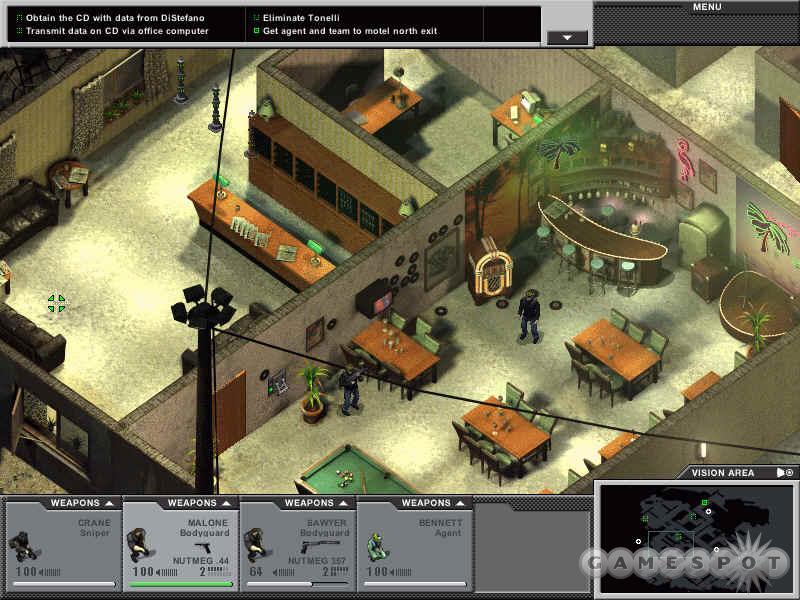At first glance, Beyond the Law: The Third Wave appears to be a budget knockoff of the Commandos series, because it's a squad-based strategy game that allows you to control specialist agents in real time in a 2D, isometric battlefield. Though calling anything a "budget knockoff" isn't exactly high praise, the description is actually a generous one for this game. The Third Wave is embarrassingly primitive in every conceivable way.

Even the game's story is poorly contrived. Set in the modern day, the game depicts the United States as a country that's being overrun by insidious forces. Bribery, prostitution, money laundering, blackmail, and other white-collar crimes run rampant, which inexplicably leads to a plot to blow up the Capitol in Washington, DC. The perpetrators? Not Al-Qaeda or other terrorists... It's the Mafia. Despite the fact that the only mob anyone in this country has worried about for the past decade or so has been Tony Soprano's on HBO, we're somehow supposed to believe that organized crime is a threat to take down the country. No matter... You're in charge of a paramilitary group tasked with rooting out the source of the organized crime in New York and New Jersey.
The Third Wave consists of 20 short levels, spread out over four main areas, including a cargo ship, an abandoned motel, and a guarded warehouse. Each time you begin a new area, you're allowed to change up your small squad of specialists for the next set of missions. The classes range from snipers to "technicals" and "bodyguards." Each class is skilled in one area, so bodyguards are the best people to have in gunfights, while technicals are the fastest people at disarming traps and breaking into computers. What's puzzling is that out of the 50 or so highly trained military personnel at your disposal, roughly half are armed with nothing but knives or pistols. You aren't given the chance to outfit your men with any new weapons; you simply hire them based on their starting equipment and live with it. There are also no special items to use--no grenades, no lock picks, and no night-vision goggles.
In practice, about half of the classes are useless. While it is sometimes useful to have a stealthily inclined agent to knife unsuspecting Mafioso in the back, you can get through the bulk of the levels with just gun-toting bodyguards and snipers, killing off all enemies. The game's missions range from hostage rescue to demolitions to assassination. Aside from gun-armed goons, you'll also deal with guard dogs, infrared cameras, motion detectors, and laser trip wires. However, most of the traps can be disabled by flipping a switch somewhere on the map or by having one of your men disarm them directly.
If the gameplay sounds simplistic, that's because it is. You have very few options aside from moving and shooting. You can't climb fences. You can't loot bodies. You can't lie prone. You can't even reload your weapon manually, but that doesn't really matter because your men seem to have the ability to reload new clips instantaneously when they run out of bullets. You can, however, hide bodies, but this doesn't mean you can pick them up and move them to a dark corner. Instead, "hiding a body" in The Third Wave means your operative throws a green tarp over a fallen enemy. Amazingly enough, patrolling guards will walk by and even step on these "hidden bodies" without noticing a thing.
The computer-controlled enemies have a short cone of vision (similar to Metal Gear Solid), which means that they won't see you standing right in front of them until you get fairly close. This is just as well, because The Third Wave's weapons have laughably short effective-firing distances. Pistols are useless until you get within about 15-20 feet, but what's even more puzzling is that submachine guns and even sniper rifles are only effective a few steps beyond that. It makes you wonder what the point of a long-range rifle is when you have to get close enough to throw something at a target to hit it. Enemy guards are also supposed to have a hearing radius, but much of the time, they seem completely deaf. On many occasions, we shot an enemy with an unsilenced handgun while a comrade just a couple of steps away noticed nothing.

The game's production values are just as poorly handled as the gameplay. The Third Wave has a locked resolution of 800x600, giving it a grainy look on larger monitors. While environments have a decent amount of detail, the same can't be said of the character models, which move and animate stiffly. The sound effects aren't noteworthy in any way, but the voice acting is pretty bad. By around the second or third time one of your men answers an order with "Before you can say organized crime!", you'll be scratching your head wondering who talks this way. The game does include a handful of cutscenes, but these consist of disjointed and sloppily edited cuts of what appear to be bad gangster movies and military-gun cameras voiced-over by a melodramatic narrator.
Despite its budget pricing, there's really no reason anyone should play Beyond the Law: The Third Wave. Its gameplay is simplistic, the enemy artificial intelligence is practically brain-dead, and its production values are rather poor. Those who enjoy good squad-based strategy games should look elsewhere for their fixes.